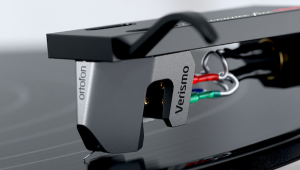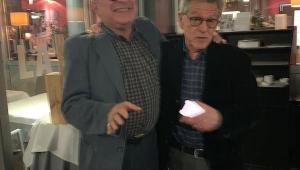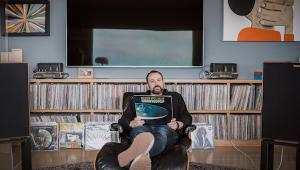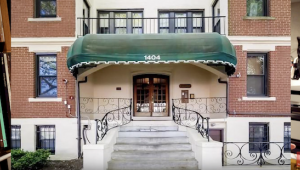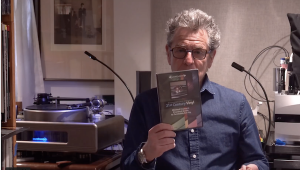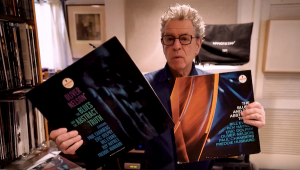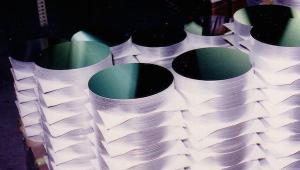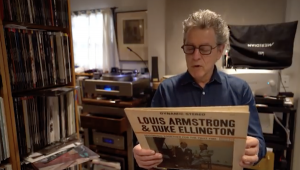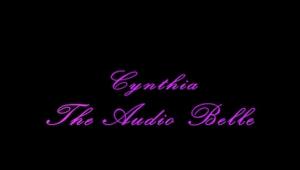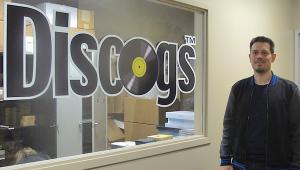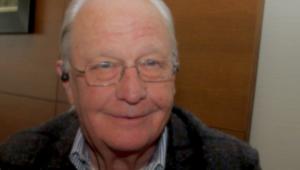A Listening Session With Bill Porter, 12/9/86
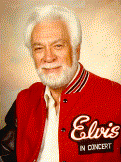
Listening session conducted at Listen Up! (thanks to Walt Stinson), 685 Pearl Street, Denver, Colorado.
Equipment:
Goldmund Dialogue Speakers
Double Kimber TC-8
Mark Levinson ML 20 amps
Mark Levinson ML 10A preamp
Goldmund turntable, T-3F arm
Carnegie Cartridge
1)Everly Brothers: “ ‘Til I Kissed You”: The Fabulous Style of the Everly Brothers. [(Archie Bleyer (prod.); Bill Porter (eng.).] Rhino RNLP 213
BP: It sounds fairly close. It’s been a long time since I’ve heard the original. But the boys “anchor out” a little bit too much in the mix, and it sounds somewhat dead. The drumsI don’t remember them being that loud. The frequency response sounds pretty good.
MF: So they didn’t play around with EQ.
BP: No, but it sounds a little disconnected to me, almost like they overdubbed the partthe way the mix is. I don’t see how they did that, unless they had the three-track tape to work with and they pulled the voices from the middle track.
MF: What about the possibility that this kind of high-fidelity equipment is simply able to separate out parts that were sufficiently buried in what you were monitoring on in those days?
BP: Well, they must have something new going on that I don’t know about!
2)Everly Brothers: “On the Wings of a Nightengale”: EB 84 (The Everly Brothers’ “comeback” album, released in 1984). [Dave Edmunds (prod.); Carey Taylor (eng.).] Mercury 822 431-1 M-1

BP: Well, not knowing what the engineer did, it’s difficult to analyze it. I don’t like the so-called modern-day electronic echo, nor do I care for the drum sound, which sounds like a digital sampler.
MF: Probably is.
BP: And the guitar sound, I didn’t like it at all. It sounded synthetic.
MF: The guitar has natural warmth and zero ambience.
BP: No. None at all. It’s a dumb phrase, but the it sounds very stringy.
3)Every Brothers: “Lucille”: A Date with the Everly Brothers. [No producer listed; Bill Porter (eng.).] Warner Brothers W 1395

(This cut, from an album Porter brought along, was used as a reference, something we should have done at the outset, to help familiarize him with the stereo system.)
BP: You hear how that mix sounded? They (the Everlys) were buried more down in it and more ambience? That’s how the first thing you played should have sounded. Now how they pulled that out and made it sound like that, I don’t know. I can’t even speculate on that.
MF: Hey! I know what! I brought along another Rhino record, All They Had to Do Was Dream (Rhino RNLP 214). It has an alternative version of “ ‘Til I Kissed You” and that’s what I played.
BP: See? They don’t change that much in one month from one mix to another! Now that sounds right. The drums are way up in the original you played. Drastically way up. Here, they weren’t so loud. And there’s more ambience around the guys.
MF: Do you want to hear the comparison one more time?
BP: Only for your edification; I’ve heard enough…I seem to have been blessed with a sonic “photographic memory.” I can hear a sound one time…and if I hear it again, I know exactly what to do. I showed you those Armenian albums I recorded in Las Vegas? The guy came in and he says, “Do you know what Armenian music sounds like?” And I said, “I’m not sure.” So he starts telling me what it sounds like and we’re killing a lot of time. So I say, “Look, if you don’t mind, why don’t we just start getting a mix on this stuff as they play it and then you tell me if it’s what you want.”
So I did, and he came in and listened and he said, “My God! That’s perfect! When did you hear music like that?” I said “When I was a kid I used to listen to the radio a lot and I happened to have heard what turns out to be Armenian music.” So I guess this blessing has helped me engineer sessions where I’ve supposedly never heard that kind of music before.
4)Elvis Presley: “Don’t Be Cruel”: Elvis’ Golden Hits. [No producer or engineer listed.] RCA LPM 1707RE 2 “black dog” label vs. “digitally remastered” RCA AFM 1 5196

BP: The digital remaster sounded much cleaner. Now, I wasn’t there at those early sessions, but what I hear sounds more like what would be coming off the speakers live at the session. As you are well aware, analog tapeand I hate so say this because I love analog sound betterbut after 24 hours with analog tape, you can forget some of the high end because it’s not there anymore…but the digital remaster definitely sounded better. That’s probably close to how the original session sounded, too. Notice the definition on the bass, right off the bat. That’s the way it should sound if you were listening to it live.
MF: The bass sounded improved to me, it’s that just his voice….
BP: Well, it’s probably characteristic of the microphone. In that day and time, I know RCA used a 77D, which was a ribbon mike, and ribbons by their very nature are not as effective on the high frequencies because you’re moving a lot of mass there compared to a condenser mike. But there was a sharpness. It may have gotten rolled on the original.
5)Roy Orbison: “Candy Man” and “Crying”.[Fred Foster (prod.); Bill Porter (eng.).] 45rpm reference pressing made by Porter immediately following the session vs. Monument M 4009 45rpm single

BP: You asked the question was this all done live. The answer is yes. Ninety-nine point nine-tenths percent of everything I did was that way, unless we had overdub of the harmony parts. What you heard is what you got, as it happened. That particular date was done early, early morning, starting around 1AM. Fred Foster, the producer, wanted to do something a little bit different and he brought a couple of six packs of beer in so everybody would feel kind of loose, you know drugs weren’t done at that time…
MF: Hey! That’s drugs!
BP: Depends on what you want to call drugs…But notice the sound is much dryer on “Candy Man” and the reason is that there was more of a Black kind of sound. And you notice the drums have no “up-frontless” to them and sound kind of dead? Well, that was intentional, as well. The drummer, Buddy Harmonan excellent drummerhad his drums tuned for a typical session. Most of the Black bluesy music at that timethey didn’t have very good instruments and they always had a deadness to them because they were just plain worn out.
And so I told him I wanted to get kind of a dead sound out of the toms. He said, “Well, I can’t get it.” I said, “Let me try something.” So I went into the bathroom, picked up some old towels, brought them out and put them on the drums. He said, “My God, I gotta hit it too hard, I can’t play like that.” I said, “Will you please try? Because that’s the sound I want to get.” Of course, Fred always let me do what I wanted to do.
MF: You were calling yourself an engineer, but in today’s terms, you were acting like a producer.
BP: You notice the kind of “chunk chunk” rhythm? Orbison’s playing that whilel he’s singing. The amp was way across the room because we didn’t want it too close to his microphone. And the two girls singing are Anita Kerr and Dottie Dillard. They’re part of the Kerr Triominus the guys [sic]. The harmonica player is Charlie McCoyyou still see him on Nashville recordings. And Boots Randolph noodling on the saxophone in the background.
I found the original demo Fred heard that made him pick the song up, and the arrangementyou wouldn’t hardly recognize the song. It was real up-tempo with a lot of brass. The musicians fell into the arrangements at that time in Nashville because they left things the way they heard them on demos. Unless someone had an ideawhen they’d be listened to. My contribution kind of fell along with theirs…
I mastered a lot of the 45s for Monument and Orbison in the RCA Nashville studio because I wanted to be sure I got the right sound. Now, we weren’t equipped to cut LPs properly because we lacked the proper spotting approach, automation and so forth, so everything was done manually including the spiraling. I got pretty good at that!
But anyway, I used the master tape before I shipped it off. I was the kind who didn’t want to make a lot of copies of tapes, because every time you made a copy it was another generation…obviously I made a safety copy. I wasn’t stupid!
6)Roy Orbison: “Candy Man”: The All Time Greatest Hits of Roy Orbison. [Fred Foster (prod.); Bill Porter (eng.).] Monument [CBS] KZG 31484

BP: What you’re hearing is the vocals lacking in high-frequency response. Knowing how that session was done, the vocals were split to tracks one and two, and the harmonica was on the left, the singers on the right, and they sound pretty normal. So I don’t know what happened with their processor. Maybe some sort of phase shift somewhere…
7)“Only the Lonely”: The All Time Greatest Hits of Roy Orbison.Same as (6) above.
BP: …it was on the tape, initially (extended high frequencies), but that record they mastered…whatever they did to it, they exaggerated itdrasticallyconsiderably.
MF: They trashed it! That’s what they did, in my fanatical book.
(This is not referring to the 2005 S&P reissue, which is, of course, sonically outstanding!)-MF2007
8)“Only the Lonely”: Lonely and Blue. [Fred Foster (prod.); Bill Porter (eng.).] Monument SLP 18002.

MF: The original (Porter’s personal copy) is so much better than the re-releasedamn it!
BP: I concur. Of course that Lonely and Blue is from the initial pressing. You know, this discussion we’re having about some of these re-issues sounding overly bright: I think that’s a characteristic of where engineers are nowadays. Whatever reasons…I mean, you could say they are all hard of hearing, etcetera, etcetera, who knows? But everybody is into much more high end, and that’s an equalization characteristic. Of course, it may depend on the kind of speakers you listen to. If you listen to fairly dull, dead speakers, he’s going to compensate for that.
MF: Ever hear a Yamaha NS-10M speaker?
BP: I don’t think so.l
MF: It’s what a large percentage of studios around the country use as nearfield monitors. They’ve got a blary little tweeter that’s so bright most studios try to tame it by inserting a piece of toilet paper under the screen guard. It’s called “the Charmin Mod.”
BP: Oh! I know what you’re talking about. I haven’t heard that speaker, but I know a guy who works for AMR, which is a division of Peavey, and they sent some speakers down for me to analyze…I compared each speaker flat, then I equalized it to where it sounded good, and I sent the data to him.
He took it to the engineering people and said, “Now, Bill hears this, this, this, and that.” And the guys say, “Yeah, because here it is. What he’s hearing is in there and he’s equalizing to compensate for it.”
So I asked him why they’re making that little speaker so bright. He says, “We’re competing with the Yamaha.” And he says, “The Yamaha is so bright, people put tissue paper over the tweeter.” And I say, “My God! No wonder it sounds so awful!” I mean, it drove me up a wall listening to that thing! I couldn’t handle it!
MF: It’s an ever-increasing escalation of high end that can only go so far before people are finally…
BP: Everybody is getting deaf as a result of it.



